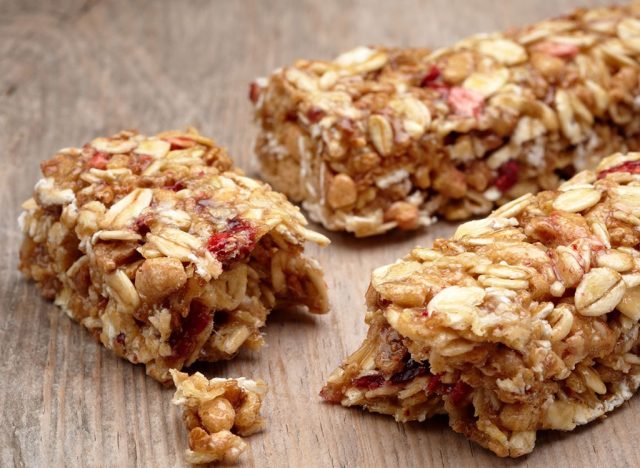There is so much fearmongering about what is in processed foods, especially when it comes to food additives that, as WHO explains, are incorporated “to maintain or improve its safety, freshness, taste, texture, or appearance.” While a diet excluding all processed foods or one that allows for food items with minimally processed ingredients certainly represents a healthy ideal, the additive component of processed foods isn’t always the driving factor behind why it’s perhaps considered harmful to your health. To get a better sense of some common food additives, including how they actually affect your diet and overall health, we consulted a few nutrition experts for their insight.
As the FDA notes, “any substance that is intentionally added to food” is considered a food additive. Furthermore, the FDA has a strict screening process to evaluate food additives, which determines whether or not the additive in question is potentially toxic or generally recognized as safe (GRAS). In fact, there are a number of food additives that are banned because they are regarded as illegal substances, and the FDA tightly regulates this.
So while having a healthy curiosity about what food additives really are and how they may potentially impact your body is completely natural and understandable, you don’t need to consume yourself by obsessively splitting hairs over them. If your aim is to do better for your body, it’s more important to place greater emphasis on eating nutrient-dense foods while carefully regulating the amount of ultra-processed foods you eat, if not avoiding them completely.
“The ‘clean eating’ trend has fueled the fear around the word ‘additive,'” Dr. Shyamala Vishnumohan, Ph.D., APD, a food scientist and dietitian, tells Eat This, Not That! “It’s important that we shift the focus more on limiting consumption of ultra-processed foods that are light on nutrients and [not] energy dense, rather than fearing food because ‘additive’ is perceived as a dirty word.”
Because the occasional splurge with a processed treat or consuming foods containing processed ingredients is bound to happen sooner or later, you should be aware that like most things, some additives may serve you and your health better than others. Are there any food additives you should absolutely avoid, and which food additives perhaps seem bad for you but really have a bark that’s worse than its bite?
Here’s what these nutrition experts had to say about exactly which food additives you should—and shouldn’t—worry about. And for more useful healthy eating advice, be sure to also check out 10 Dietitian-Backed Food Trends You Should Try in 2023.
Food Additives to Avoid
Red dye 40
While the FDA has qualified and labeled all food dyes as GRAS, some research acknowledges that there may be a connection between red dye and hyperactivity and aggression in kids. However, more evidence is needed to support a conclusive statement.
“Although more research is needed at this time, it may be worth trying to avoid red dye 40—a synthetic food dye made from petroleum—in children with ADHD,” says Megan Warnke, RDN. While health organizations have concluded red dye 40 poses little health risk, some studies have found its consumption may lead to mild allergic skin reactions and worsen behavioral symptoms in children with ADHD.”
Nitrates & nitrites


Although many nitrates we consume come from plants, there is growing evidence that nitrates and nitrites added to processed meat are linked to certain cancers, particularly those that can impact your stomach and colon.
“I recommend avoiding nitrates and nitrites found in packaged meats like bacon and lunch meat,” advises KeyVion Miller, RDN, LDN, a dietitian and culinary nutritionist. “These additives have been shown to possibly contribute to an increased risk of colon cancer.”
Maltodextrin
Although more research in humans is needed before we can make conclusive claims about the potential dangers and health risks associated with this food additive, there does seem to be some evidence to suggest that maltodextrin can disrupt a healthy gut.
“Maltodextrin is added to foods to improve texture, flavor, and shelf-life,” says Kim Kulp, RD, a registered dietitian at the Gut Health Connection. “While generally considered safe, one [2018] study in mice shows it may increase the number of harmful microbes in the gut, and damage the lining of the intestines. These changes may lead to an increased risk of inflammatory bowel disease.”
READ RELATED: Fiona Castle and Cathy Brokenshire campaign for lung cancer screening
Additives That Seem Scary—but Are Actually Safe
Guar gum
While putting gum in food may sound concerning, guar gum is an additive you don’t have to fear. In fact, guar gum is a type of fiber that has a functional purpose in our food supply as well as some potential health benefits.
“Guar gum is a long-chain carbohydrate used by the food industry to thicken and bind foods such as ice cream, soups, and sauces,” explains Dr. Vishnumohan. “Guar gum is safe in moderation for most people, and sourced from a legume called guar beans. It is high in fiber and has been associated with better digestive health as well as increased feelings of fullness.”
Cellulose


Cellulose is often seen on the ingredient list of foods like shredded cheese, baking mixes, some cereal and granola bars.
According to Andrew Akhaphong, MS, RD, LD, a registered dietitian for Mackenthun’s Fine Foods, there are many misconceptions about cellulose and its origins, which likely stem from its chemical structure.
“Cellulose is used as an anti-caking agent to prevent the ingredients from sticking together,” he says. “Influencers often talk about avoiding products with cellulose, as they are ‘from’ trees or ‘made’ from wood pulp. Although trees do contain cellulose, the cellulose [we eat] comes from all plant foods, including celery, spinach, beans, as well as some nuts and seeds.”
“Cellulose is the same structure chemically—regardless of what tree or plant it comes from,” Akhaphong adds.
Akhaphong further claims that cellulose is not only safe to consume, but also it can yield a slew of health benefits.
“Cellulose is completely harmless,” says Akhaphong. “In fact, as an insoluble fiber, cellulose reduces constipation and colon cancer risk, improves the feeling of fullness, and supports bowel movement.”
Ascorbic acid
Ascorbic acid is a great example of an additive that may give off an unsettling impression and seem scarier than it really is. In actuality, ascorbic acid is really just the scientific name for vitamin C.
According to Shannon Western, ANutr, founder and lead nutrition counselor at Ease Nutrition Therapy, the reason why it is frequently added to foods is because it helps preserve items to sustain their shelf-lives.
“There’s a trend of not eating foods that contain unfamiliar ingredients. One ingredient that sounds unfamiliar is ascorbic acid,” says Western. “This is simply vitamin C, written in its chemical name. Ascorbic acid is used as an additive to improve self life, meaning that foods can last longer without going rancid. This is because vitamin C is an antioxidant.”
Source:









